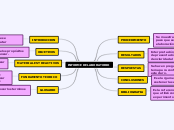PUNCION VENOSA
To name your story, you have to think about the overall message and what you want your audience to understand from the story. Also, make it relevant and easy to remember.
PROCEDIMIENTO
The ending of a story is essential. We all know that if the ending is weak, what happened before loses its importance. So make it unpredictable, but fair. A resolved ending answers all the questions and ties up any loose threads from the plot.
This is the closure section of the story.
See examples of possible outcomes below:
- all problems have been solved
- it's clear how each one of your characters ends up
- your main character is transformed by the challenge
La zona se limpia con un antiséptico.
Se punza la piel del dedo, el talón u otra zona con una aguja afilada o una lanceta.
La sangre se puede recoger en una pipeta (tubo pequeño de vidrio), en un portaobjetos, sobre una tirilla de examen o en un recipiente pequeño.
Se puede colocar algodón o un vendaje en el sitio de la punción si hay algún sangrado continuo
Try answering these questions in order for you to come up with a closure:
- Have all problems been solved?
- Is it clear what happens with all your characters in the story?
- Has the challenged transformed your main character?
- How do the characters feel in the end?
This is the moment when the main character surpasses the last obstacle and finally faces their greatest challenge.
The climax usually follows one of these patterns:
- realization
- resolution
- choice
Type in your answer.
El sitio se limpia con un desinfectante (antiséptico).
Se coloca una banda elástica alrededor de la parte superior del brazo con el fin de aplicar presión en la zona. Esto hace que la vena se llene de sangre.
Se introduce una aguja en la vena.
Se recoge la sangre en un frasco hermético o en un tubo adherido a la aguja.
La banda elástica se retira del brazo.
Se saca la aguja y el sitio se cubre con un vendaje para detener el sangrado.
OBJETIVO
The middle of the story is where you add layers of complications that will lead to the end. Reveal more about the character's journey. Did their personality go through changes? How did they overcome the challenges? And as you build up the story’s central conflict, make it more personal to that character. Also, from the middle act, you have to lead into the final act.
TOMA DE MUESTRAS
There wouldn't be any tension and excitement in your story if there weren't any obstacles in your character's way.
Conocer los requerimientos significativos de una toma de muestra venosa Identificar errores preanalíticos en la toma de muestra Identificar efectos adversos de una venopunción
Your character(s) need(s) motivation in order to solve the challenge(s).
Conocer los métodos de extracción sanguínea.
Realizar correctamente la extracción de sangre capilar.
Secondary characters also might have motivs beacuse of which they may cross path with main character or which might trigger them to help the main character.
QUE ES
In the beginning of the story (or the exposition), you will need to introduce the setting and characters. You might also want to introduce the main conflict. This part of the story is important because it gives the reader necessary background information and maybe even a first insight into a character’s personality.
Procedimiento para el que se usa una aguja para extraer sangre de una vena; habitualmente, para hacer pruebas de laboratorio. Una punción venosa también se realiza para remover el exceso de glóbulos rojos de la sangre, para tratar ciertos trastornos de la sangre.
PUNCION CAPILAR
La punción capilar consiste en pinchar el pulpejo del dedo o el lóbulo de la oreja con una lanceta. En niños menores de 4 años se realiza en el talón del pie.










